 image
by Marcus Schmöger, 27 Mar 2004
image
by Marcus Schmöger, 27 Mar 2004

Last modified: 2006-08-12 by bruce berry
Keywords: zimbabwe | zanu | zapu | super-zapu | mdc | rf | uanc |
Links: FOTW homepage |
search |
disclaimer and copyright |
write us |
mirrors
 image
by Randy Young, 26 Jan 1999
image
by Randy Young, 26 Jan 1999
This is the flag of the current ruling party in Zimbabwe, based on the
description given to me by Bruce Berry: "The flag of the ruling Zimbabwe African
National Union - Patriotic Front (ZANU-PF) in Zimbabwe consists of a series
of concentric rectangle stripes which are from the outside moving in towards
the centre: green, gold, red, and black (as in the colours of the Zimbabwe
flag). For example, the green stripe borders all sides of the flag, followed
by a yellow stripe and so on until there is a solid black rectangle in
the centre. Each stripe is of equal width (as in the Zimbabwe flag) and
the flag is 1:2. The Zimbabwe flag is based directly on the colours of
ZANU-PF and the symbolism of the colours is the same."
Randy Young, 21 Jan 1999
Some years ago I received from Michael Faul, membership secretary of The Flag Institute and a former citizen of Rhodesia/Zimbabwe, colour drawings of the flags of four political parties of Zimbabwe used in the 1980 independence election. There were five flags, one for ZAPU used before the election, and one for ZAPU (PF) used during the election. (ZANU and ZAPU formed a coalition called the Patriotic Front, and both parties used the PF after their names. ZANU, the ruling party since 1980, is still known as ZANU-PF).
The flag Mr. Faul shows as being used by ZAPU-PF in the 1980 election is the same as that described and illustrated earlier, with a yellow vertical bar, and black/red/green horizontal bars, al with different coloured stars. However, unlike the description and illustration previously provided to this list which shows a red star on the black stripe, Mr. Faul's drawing has a white star on the black stripe. The red star would have been consistent with the older ZAPU flag described by Bruce Berry (four stripes, red/green/yellow/black, with black and yellow stars at hoist and fly of the red stripe, and red and green star at hoist and fly of black stripe, with a badge in centre showing the Great Zimbabwe ruins).
I asked Mr. Faul about this, and he affirms that the flags he saw in
Zimbabwe during the 1980 election used the white star on the black bar.
He also noted that he never saw an actual flag, but representations of
the flag printed on political posters and T-shirts.
Devereaux D. Cannon, 20 Mar 2001
![[ZAPU flag]](../images/z/zw}zapu.gif) image
by António Martins-Tuválkin, 14 Mar 2001
image
by António Martins-Tuválkin, 14 Mar 2001
"Nations Without States" (James Minahan, 1996) states that the
party flag of the former ZAPU (Zimbabwe African People's Union) is the
one used as a flag by the Ndebele people of Matabeleland. At
FOTW's Zimbabwean Political Flags page there is a mention of the ZAPU flag,
but no description. Minahan gives it as a horizontal tricolor with a vertical
stripe along the hoist. This vertical hoist stripe is yellow, with a black
5-pointed star. The three horizontal stripes are black with a red 5-pointed
star; red with a green 5-pointed star; and green with a yellow 5-pointed
star. In each case the star is shown as centered, and almost but not quite
touching the top and bottom of the stripe (or left and right edge in the
case of the vertical stripe of course). Overall the flag's ratio is shown
as 2:3, and the width of the vertical stripe equals the height of one of
the horizontal stripes (based only on observation of the line drawing,
specifications not given).
Ned Smith, 14 Mar 2001
The flag used by the Zimbabwe African People's Union (ZAPU) during the liberation struggle against the minority-regime in Rhodesia in the 1970s is not the same as that described by Ned Smith as being used by the Ndebele in Zimbabwe. ZAPU was headed by the late Joshua Nkomo and had a guerrilla force know as the Zimbabwe People's Revolutionary Army (ZIPRA) which operated mainly from bases in Zambia. ZAPU, together with the Zimbabwe National People's Union (ZANU) led by Robert Mugabe and its forces known as the Zimbabwe National African Liberation Army (ZANLA) which operated mainly from Mozambique, formed a political alliance known as the Patriotic Front (PF). At the time of the pre-independence elections in 1980, the parties spilt into their respective factions as ZANU-PF and PF-ZAPU. ZAPU was predominantly Ndebele (from the south and west of the country) and ZANU was predominantly Shona. The Shona comprise approximately 80% of the population and hence it was not surprising that ZANU-PF won the elections. In December 1987 a Unity Accord was signed between the two parties whereby ZAPU was incorporated into ZANU-PF and Joshua Nkomo became one of two vice-presidents of Zimbabwe.
The flag used by ZAPU during the 1970s comprised four horizontal stripes of red, green, yellow and black. In the centre was a representation of the Great Zimbabwe Ruins in black within a circle on a white/beige background. There were also four five-pointed stars - one at each corner of the flag. These were also in black, yellow, red and green. This flag was also used by the ZIPRA forces and was rarely seen following independence in 1980. It was certainly not used after the Unity Accord in December 1987 when ZAPU, to all intents and purposes, ceased to exist as a separate political entity.
The flag mentioned by Ned Smith does contain some of the central elements
of the former ZAPU flag. The current situation in Zimbabwe has seen
growing political opposition to the ruling ZANU-PF party but I am not aware
that ZAPU, as a political party, has been revived.
Bruce Berry, 15 Mar 2001
As far I know, the new ZAPU flag adopted at end of 1979 or in 1980 was used in Matabeland in 1982-1986, when Nkomo broke with Mugabe, and liberated zones were created in two provinces of Matabeland. As party flags the upper star is reported white in Flagmaster. 1986 reconciliation took effect and ZAPU was absorbed into ZANU-PF in 1987. During 1987-1988 Super-ZAPU operated in Matabeleland, sponsored by South Africa, which opposed Mugabe. I don't have any knowledge of its flag, but given its covert nature, it is unlikely to have had one.
Revolutionary flags:
UANC (Bishop Abel Muzorewa) two successive flags (before 1979 and after 1979)
ZANU and ZANLA (concentric rectangles, several versions reported)
ZAPU and ZIPRA, as indicated by Bruce. The stars are not clear. Flagmaster
reported yellow near hoist and black in fly but I believe that is the single
source for this, rest say black in hoist in yellow in fly. Mainly sources
give green star near hoist and red in fly (I don't know any source that
gives red star near hoist)
Patriotic Front 197?-1979 (I don't know if a single unified flag exist)
Party flags
ZANU-PF after 1979. Unknown but perhaps same as before.
ZAPU-PF, as reported by Minahan 1979/80-1987 (white upper star according
Flagmaster)
Jaume Ollé, 25 Mar 2001
Yesterday I saw a CD cover for the CD "Survival" by Bob Marley &
The Wailers. The cover contains 49 flags (which all appear to be
African Nationals except for Papua/New Guinea). Several of the flags
are older versions (the CD dates from 1990), but there was one that I could
not identify. It is divided horizontally with even stripes of red-green-yellow-black.
Going clockwise in the corners from upper left are stars, yellow-black-red-green.
In the center is a white disk with black images that kind of look like
a village.
Michael Smuda, 8 Aug 2001
This is the flag of ZAPU - the Zimbabwe African People's Union- during
the 1970s.
Ned Smith, 9 Aug 2001
 image
by Marcus Schmöger, 27 Mar 2004
image
by Marcus Schmöger, 27 Mar 2004
During some recent research into German political flags I came across an
article in DKP (German Communist Party), "Unsere Zeit" of 17 Feb
1975 about a "tribunal against colonialism and apartheid" which had been held in Bonn (Germany)
and where the above flag was shown. Participants of the meeting were from South Africa, Namibia and Zimbabwe: ANC, SWAPO, ZANU and ZAPU.
Marcus Schmöger, 27 Mar 2004
This flag of ZAPU (Zimbabwe African Peoples Union) is shown in The Flag Institute Bulletin
(No. 005 of 01.08.1978) and in an article in the Czech Vexilologie
journal (No.18 of March 1976) by Pavel Fojtik and Jaroslav Martykan on the Flags of
Freedom. It is also discussed in other vexillological bulletins such as Vexillinfo by
R.Baert and Flaggenmitteilung by G.Mattern.
The flag is composed of horizontal stripes (from top to bottom) of red, green, yellow and
black and stars (from a star at a staff above, clockwise) of yellow, black, green and
red. In the center on a white circle is a stylized image of the ruins
of ancient Zimbabwe in black and two black trees.
Mikhail Revnivtsev, 28 Mar 2004
I know the sources quoted but I believe the central circle is yellow and not
white. The order of the stars I believe is (starting from the upper hoist corner, clockwise) black, yellow, red and green.
Jaume Ollé, 29 Mar 2004
Yes, in Vexilologie No. 18 (p.233) the central disc is described as yellow.
In the Flag Institute Bulletin No. 005 (sheet 4) colour of this disk was not specified.
In the German (GDR) magazine Urania I saw in 1970 it shows a white disk.
Again, in Vexilologie No. 18 (p.233) order of an arrangement of colour stars on a flag is
as indicated by Jaume. But again, in The Flag Institute Bulletin No. 005 (sheet 4) and
Urania, the colours are given as yellow, black, green and red.
This is probably because the flag was never officially authorised and variations
occurred
during manufacture.
Mikhail Revnivtsev, 30 Mar 2004
Several flags have been mentioned for ZAPU. Prior to independence ZAPU used the
four-stripe flag with an image of the Great Zimbabwe ruins as shown above.
A second design, with the same colours, was used later: The pattern is curiously
similar to the Boer Vierkleur flags (a 2:3
horizontal tricolor with a vertical stripe near the hoist: (2+2+2):(2+7), with
one star centered on each stripe.
On 14 Mar 2001, Ned Smith reported from [mnh96] «a horizontal tricolor with a
vertical stripe along the hoist. This vertical hoist stripe is yellow, with a
black 5-pointed star. The three horizontal stripes are black with a red
5-pointed star; red with a green 5-pointed star; and green with a yellow
5-pointed star. In each case the star is shown as centered, and almost but not
quite touching the top and bottom of the stripe (or left and right edge in the
case of the vertical stripe of course). Overall the flag's ratio is shown as
2:3, and the width of the vertical stripe equals the height of one of the
horizontal stripes» (this comes from our page).
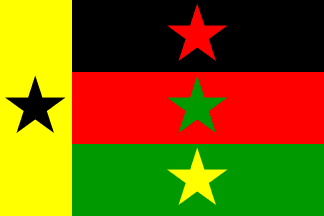 image by António Martins-Tuválkin, 09 Dec 2005
image by António Martins-Tuválkin, 09 Dec 2005
On 25 Mar 2001, Jaume Ollé (also edited in our page) wrote that «Flagmaster
reported yellow near hoist and black in fly but I believe that is the single
source for this» (though a week earlier, Ned had reported a different source for
this design: [mnh96]) «rest say black in hoist
in yellow in fly.»
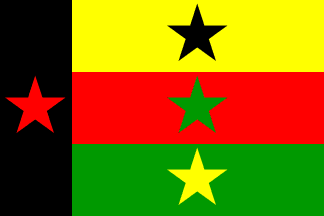 image by António Martins-Tuválkin, 09 Dec 2005
image by António Martins-Tuválkin, 09 Dec 2005
On 25 Mar 2001, Jaume Ollé wrote «Mainly sources give green star near hoist and
red in fly (I don't know any source that gives red star near hoist)».
Now I'm fully confused: Is this a third design, or just star colour specs for
the previously described ones? Which star goes on which stripe in which
source?
António MARTINS-Tuválkin, 09 Dec 2005
Yes, it is true that there was a movement called "Super-ZAPU", which
was supported by the apartheid regime in South Africa against the Mugabe
government in Zimbabwe in the 1980s. This support would have been along the same lines
as the support given to Renamo in Mozambique against Frelimo and was part
of the "destabilisation" efforts of the former South African government
in southern Africa. I am not aware of any flag used by Super-ZAPU. Unlike Renamo, the movement
did not survive for long and the "Unity Accord" between ZAPU and ZANU saw
Nkomo and Mugabe patch up their differences and the two political parties
merged and Nkomo became Vice President of Zimbabwe. Numerically the Ndebele
only account for 20% of the population of Zimbabwe, so they are unlikely
to be more than a minority political force
Bruce Berry, 14 Dec 1998
![[Movement for Democratic Change]](../images/z/zw}mdc.gif) image
by Zach Harden, 17 Mar 2002
image
by Zach Harden, 17 Mar 2002
The Movement for Democratic Change, or the MDC, is the official opposition
which contested the recent
parliamentary and presidential elections in Zimbabwe. Even though they lost, their
flag has been seen across the country.
The flag is in a 1:2 ratio, the same as the national flag of
Zimbabwe.
The colour of red, black, green and yellow are present because those
colors not only derive from the national flag, but are the traditional colours of the Africa. The open hand on the flag is the election symbol
of the MDC and it represents transparency. It is holding nothing,
hiding nothing, showing commitment to change in Zimbabwe. The flag was shown in a Yahoo News Photo covering the elections.
Zach Harden, 17 Mar 2002
![[MDC logo]](../images/z/zw})mdc.gif) image sent by Zach Harden, 17 Mar 2002
image sent by Zach Harden, 17 Mar 2002
The open hand, the election symbol of the Movement for Democratic Change,
was chosen as it represents transparency : We have nothing to hide,
we carry no weapons and we promote the ideals of a peaceful democracy.
In addition it illustrates that each one of us has the power to change
the current political status quo in Zimbabwe. We have that power in our
hand and we can exercise it when we vote in this year's elections.
Our Slogan: In Shona - "Chinja Maitiro, Maitiro Chinja". In Ndebele
- "Guqula Izenzo, Izenzo Guqula".
The closest English translation is; "Now is the time, fight for
change, support the Movement"
Info from the MDC
website.
Zach Harden, 17 Mar 2002
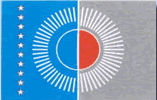 image
sent by Chrystian Kretowicz, 15 Nov 2005
image
sent by Chrystian Kretowicz, 15 Nov 2005
Originally reported on our sister mailing list, Russovex - by the member
from Latvia, the website at: http://www.mthwakazionline.org/Editors.html
shows the statement by the movement for the creation of the break-away state
containing Matabeleland and Midlands parts of Zimbabwe for the Ndebele
people called the United Mthwakazi Republic.
This page shows the purported emblem and flag of the movement, while the flag
and detailed description of the symbols and colours is displayed at:
http://mthwakazionline.org/Flag.html as shown above.
The flag of Mthwakazi contains a very unusual colour - gray.
Chrystian Kretowicz, 15 Nov 2005
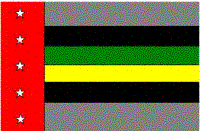 from
http://www.mthwakazionline.org/index.html
from
http://www.mthwakazionline.org/index.html
Mr. Ilmârs Bite from Latvia posted on Russovex mailing list yet another flag of
the Mthwakazi Republic (Matabeleland). The flag can be seen at:
http://www.mthwakazionline.org/index.html.
Chrystian Kretowicz, 22 Dec 2005
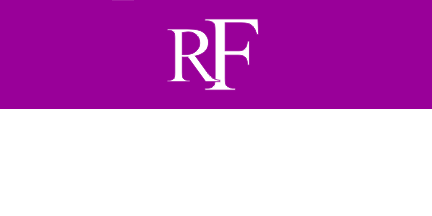 image by
Martin Grieve, 31 May 2005
image by
Martin Grieve, 31 May 2005
The Special Edition
Newsletter published by the Société Française de Vexillologie to commemorate its
20th anniversary illustrates the flag used by the Rhodesian Front. The flag is
divided horizontally purple over white, with the party's "RF" logo in white on
the upper purple stripe. The symbolism of
the colours is unknown.
The
Rhodesian Front was founded in 1962 and was the governing party in what was then
Rhodesia between 1964 and May 1979. Under the leadership of Ian Smith, who
became Prime Minister of Rhodesia on 14 April 1964, Rhodesia declared a
Unilateral Declaration of Independence (UDI) from Britain on 11 November 1965.
This was later declared illegal by the United Nations which imposed mandatory
economic sanctions on the country. The Rhodesian Front advocated that the
government of the country should remain in "responsible hands" and was opposed
to communism and the compulsory integration of Africans and Europeans in
Rhodesia. The party won all 50 "European" seats in the Rhodesian parliament in
1970. Following the "Internal Settlement" between the Rhodesian Government and
internally based African nationalist leaders on 03 March 1978, universal adult
suffrage elections were held at the beginning of 1979 which led to a victory by
the United African National Council (UANC) led by Bishop Abel Muzorewa. Bishop
Muzorewa became Prime Minister of a Government of National Unity, including the
Rhodesian Front, when the country became Zimbabwe Rhodesia on 01 June 1979. It
was this Government of National Unity which entered into negotiations with the
externally based African nationalist leaders of the Patriotic Front, led by
Robert Mugabe and Joshua Nkomo, at Lancaster House in London at the end of 1979 and which
finally arrived at an agreement which led to the return to legality of the
government of Zimbabwe-Rhodesia. The country returned to a brief period of
direct British rule following the arrival of Governor Lord Christopher Soames on
12 December 1979 whose task was to monitor the ceasefire, supervise elections
and transfer power to a new government in terms of the Lancaster House
Agreement.
In terms of
the Lancaster House Agreement, there were 20 seats in the Zimbabwean parliament
specifically reserved for "Europeans". These were held by the Rhodesian Front,
which changed its name to the Republican Front following the independence of
Zimbabwe in April 1980 and later to the Conservative Alliance of Zimbabwe (CAZ).
Ian Smith remained leader of the party until 1987. The reservation of "white"
seats in the Zimbabwean parliament ended in 1990 and the CAZ has since faded
from the political landscape in Zimbabwe.
Bruce Berry,
31 May
2005
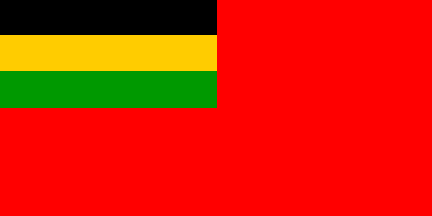 image by
Martin Grieve, 27 May 2005
image by
Martin Grieve, 27 May 2005
The
United African National Council (UANC) was led by Bishop Abel
Muzorewa and was the
ruling party in the short-lived Zimbabwe Rhodesia in 1979. Following the banning
of most African-based political parties in Rhodesia in the early 1960s, many
African political leaders were jailed or left the country. Muzorewa initially
led resistance to the Rhodesian Front regime in his pastoral capacity and formed
the UANC to represent African political opinion in opposing the constitutional
proposals negotiated by Ian Smith (for the Rhodesian Government) and Sir Alec
Douglas Hume (for the British Government) in 1971. As an internally based
African leader, Bishop Muzorewa led the UANC into the "Internal Settlement" with
the Rhodesian Government on 03 March 1978 and formed a transitional government
with the Rhodesian Front and other political parties, winning the first
universal adult suffrage elections held in the country in April 1979 with 67% of
the vote. A Government of National Unity was formed under the UANC when the
country became Zimbabwe Rhodesia on 01 June 1979. It was this Government of
National Unity which entered into negotiations with the externally based African
nationalist leaders of the Patriotic Front, led by Robert Mugabe and
Joshua
Nkomo, at Lancaster House in London at the end of 1979 and which finally arrived
at an agreement which led to the return to legality of the government of
Zimbabwe Rhodesia. The country returned to a brief period of direct British rule
following the arrival of Governor Christopher Soames on 12 December 1979 whose
task was to monitor the ceasefire, supervise new elections and transfer power to
a new government in terms of the Lancaster House Agreement. This was achieved
when Zimbabwe attained independence on 18 April 1980.
In the
February 1980 elections the UANC won three seats in the first Zimbabwean parliament
and remains a small political party with Muzorewa having left politics in 1986.
 image by
Martin Grieve, 27 May 2005
image by
Martin Grieve, 27 May 2005
The flag used by the UANC comprised a red field. In the canton are three horizontal stripes of black, yellow and green, the colours of the South African African National Congress (ANC) - although sometimes not in the same order. A number of variants were seen during the election campaigns in 1979 and 1980, one of which was unveiled in the town of Gatooma and photographed by the Pretoria News (28 January 1978). This flag had a red background with black, green and yellow horizontal stripes in the centre and the letters UANC in black in each corner. According to UANC Publicity Secretary at the time, David Mukome, the colours stood for the following: "The black is for the majority of the people in this country. Green is for agriculture which is the main occupation of our people. Yellow is for the minerals in general which are a major source of our foreign currency" while the red background is for the "blood that has been shed". These colours were also used in the national flag of Zimbabwe Rhodesia with similar symbolism.
 image
by
Martin Grieve, 27 May 2005
image
by
Martin Grieve, 27 May 2005
Flagmaster No. 115 (2005)
shows a UANC flag and gives the order of the colours in the canton as being
black, yellow and green. Michael Faul, the author of the article, has since
informed me that he has a hand-held flag given to UANC supporters in 1979 on
which he based his description. It appears that the order of the horizontal
stripes (particularly the yellow and
green stripes) may have differed thus leading to a number of variants of the
UANC flag.
Bruce Berry, 27 May 2005
![[ufe]](../images/z/zw}ufe.jpg) image sent by Albert S Kirsch, 17 Jan 2002
image sent by Albert S Kirsch, 17 Jan 2002
This is a photo from The Economist, (12 Jan 2002, page 15) showing
demonstrators in the latest election campaign in Zimbabwe. Can anyone identify
what flag is being flown (and echoed on one man's shirt)?
Albert S Kirsch, 17 Jan 2002